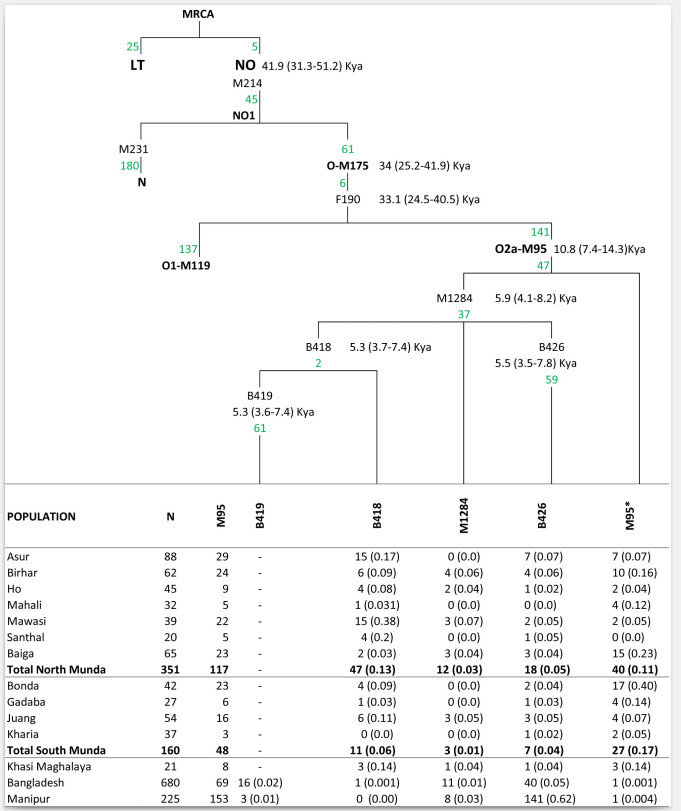
Counting the paternal founders of Austroasiatic speakers associated with the language dispersal in South Asia:
The phylogenetic analysis of Y chromosomal haplogroup O2a-M95 was crucial to determine the nested structure of South Asian branches within the larger tree, predominantly present in East and Southeast Asia. However, it had previously been unclear how many founders brought the haplogroup O2a-M95 to South Asia. On the basis of the updated Y chromosomal tree for haplogroup O2a-M95, we analysed 1,437 male samples from South Asia for various downstream markers, carefully selected from the extant phylogenetic tree. With this increased resolution, we were able to identify at least three founders downstream to haplogroup O2a-M95 who are likely to have been associated with the dispersal of Austroasiatic languages to South Asia. The fourth founder was exclusively present amongst Tibeto-Burman speakers of Manipur and Bangladesh. In sum, our new results suggest the arrival of Austroasiatic languages in South Asia during last five thousand years.
From the discussion:
The diverse founders as well as the large number of unclassified samples (41% for Mundari, 38% for Khasi and 1% for Tibeto-Burmans) suggest that the migration of Austroasiatic speakers to South Asia was not associated with the migration of a single clan or a drifted population. Neither does the contrasting distribution of various founders discovered in this study amongst both Mundari and Tibeto-Burman populations support the assimilation of the former to the latter.
For a moment I thought that this might have been a gnxp post :p
Its nice to read on different Y-haplogroup of South Asia. I hope they cover in detail other haplogroups like C,F, H, L
Nice topic but I think there is something misunderstanding. Haplogroup O was not brought to Indian but originated in Indian subcontinent. See the bigger picture of Haplogroup Tree. Haplogroup O is subset of Haplogroup F. Before it was believed that Haplogroup F originated in Siberia but now it is determined that it muted in Indian subcontinent. The macroscopic picture of Haplogroup tree is showing that it is India from where modern population started. From India people went to Europe via Arab/Levant and Swat Valley. From India people migrated towards Asia Pacific. During the LGM it was only in India and South East Asia pacific tropical. Where Eurasia was covered full of ice sheet , Arab was under high arid and habitable. Yes Levant and Northern Syria/Iraq were habitable but we see older neanderthal fossils which dated early but we find modern human remains only 15ka old. In essence, it is India the cradle of modern human population after the great migration from Africa. See the diagram of Haplogroups: https://en.wikipedia.org/wiki/Human_Y-chromosome_DNA_haplogroup
Have these guys came from India and when?
Lepenski Vir (12000 years old)
https://www.google.com/search?q=lepenski+vir&rlz=1C1GCEA_enAU795AU795&tbm=isch&source=iu&ictx=1&fir=Y2WcKQB0ft2A5M%253A%252C0a1NzJ7fAskBdM%252C_&vet=1&usg=AI4_-kSZVV2_z5lewXzEoTORvTVn52ANgA&sa=X&ved=2ahUKEwjkieOh7vnlAhUVTI8KHYabB58Q9QEwAnoECAoQMA#imgrc=Y2WcKQB0ft2A5M:
Blagotin (9000 years old)
https://www.google.com/search?rlz=1C1GCEA_enAU795AU795&tbm=isch&sa=1&ei=TcHVXbX5OYXG4-EPx-2lwAM&q=blagotin&oq=blagotin&gs_l=img.3…53247.58164..58780…0.0..0.262.3307.0j16j3……0….1..gws-wiz-img…..0..0j0i131j0i67j0i30.ziVCWUdqFms&ved=0ahUKEwj1096m7vnlAhUF4zgGHcd2CTgQ4dUDCAc&uact=5#imgrc=cEnRRPwa8yOvNM:
Vinča (8000 years old)
https://www.google.com/search?rlz=1C1GCEA_enAU795AU795&tbm=isch&sa=1&ei=icHVXeOxO-6R4-EP9s-l0AY&q=vinca+culture+figurines&oq=vinca+culture&gs_l=img.1.2.0l5j0i24l5.30798.36877..40548…0.0..0.208.3282.0j19j1……0….1..gws-wiz-img…..0..0i131j0i8i30j0i30.qEKpCkAPqEw#imgrc=TX-fInSuAmWllM:
PS: Just one figurine from Vinca:
https://www.google.com/search?rlz=1C1GCEA_enAU795AU795&tbm=isch&sa=1&ei=icHVXeOxO-6R4-EP9s-l0AY&q=vinca+culture+figurines&oq=vinca+culture&gs_l=img.1.2.0l5j0i24l5.30798.36877#imgrc=n3Q_Cq6JCRQG4M:
I think I have already responded to something like this before. These guys were mesolithic eastern Europeans + Anatolian farmers. I think that mesolithic eastern Europeans were WHG + some ANE. So WHG + some ANE + ENF. ENF was mostly Anatolian hunter-gatherer + minor Levantine neolithic input.
I am not sure if you are replying to me, because I was actually replying to the guy who said, without any explanation, that human civilisation originated in India. It is obvious that people from Lepenski Vir and Vinca, due to favourable microclimate, survived the Ice Age in Danube’s proximity and, after that, they developed first civilisations. Some later arrivals are hypotheses and still under investigation. Geneticists and others for decades avoided to research the earliest civilisations and were focusing on several thousands year later – Corded Ware, Bell Beaker, etc. That was the reason why for 200 years could not find the birthplace of “(Proto)Indo-Germanishe i.e. Indo-Europeans”. At the end, they realised that they must research the beginnings of the history and Reich’s lab for e.g. started researching of Lepenski Vir (Iron Gates).
I don’t think that civilization originated in any one place, but complex settlements in south Asia are more recent than and also unrelated to the ones in the Balkans and Anatolia. It couldn’t have anything to do with south Asia.
Flying Chariot Alert!
Perspectives have been shifting to Sundaland since the last 5 years or so. I won’t be surprised if India was the place where 2 populations- one from southeast Asia and one from southwest Asia met a long time ago, but even then I don’t think that it has significant implications for Eurasian populations at large, at least not as significant as things like the Levant Aurignacian culture. I don’t know about the phylogeny of O, but I highly doubt that its diversity peaks in south Asia.
Now finally speaking from my own perspective- I think that there was a whole lot more going on in the pre-Aurignacian Levant than what the current conception is, and the current conception places it as the region in space and time where west Eurasian cultures began. I think that the pre-Aurignacian Levant was the general region where east and west Eurasians first differentiated and also the region where mtDNA N and mtDNA M first arose.
The date of 3000 BCE for the migration of Austroasiatic-speaking clans to India from Southeast Asia seems too early to me. It must have occurred after 2000 BCE, see Tätte et al., The genetic legacy of continental scale admixture in Indian Austroasiatic speakers. Sci Rep 9, 3818 (2019).
agree. there’s overlap of author list.
Proportionally, the uniparental markers for Bangladeshis (from Dhaka – and autosomally regular Bengalis) match TB population like Manipuris (B426/B419) over Munda (B418/M95*).
Correlates with what we’ve seen autosomally.